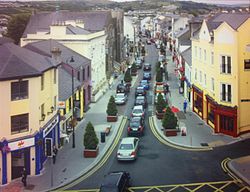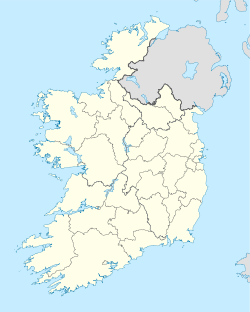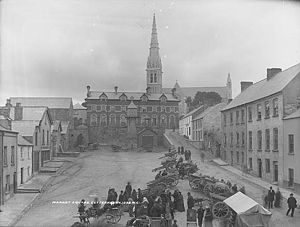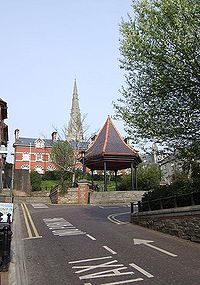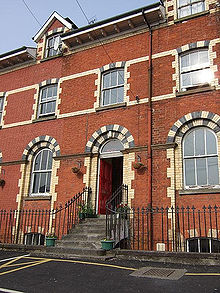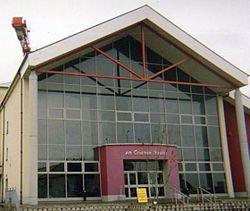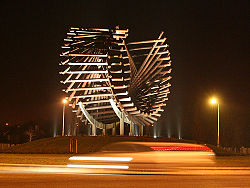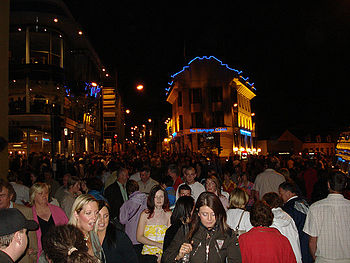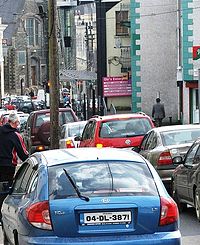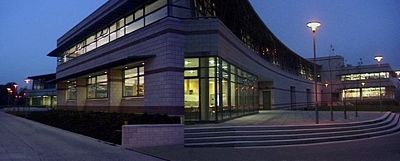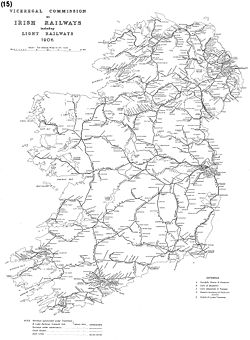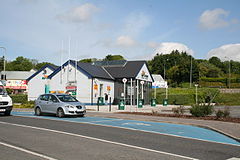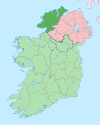- Letterkenny
-
Letterkenny
Leitir Ceanainn— Town — 
Coat of armsMotto: Ubique Urbem Reminiscar
"Remember the town wherever I am"Location in Ireland Coordinates: 54°57′24″N 7°43′13″W / 54.9566°N 7.7203°WCoordinates: 54°57′24″N 7°43′13″W / 54.9566°N 7.7203°W Country Ireland Province Ulster County County Donegal Dáil Éireann Donegal North East Elevation 52 m (171 ft) Population (2006)[1] – Town 17,586 – Urban 15,062 – Environs 2,524 Irish Grid Reference C171121 Dialing code 074, +000 353 74 Website letterkenny.ie Letterkenny (from the Irish: Leitir Ceanainn), with a population of 17,568,[1] is the largest town in County Donegal, part of the Province of Ulster in Ireland. The town is located on the River Swilly. Letterkenny, located in East Donegal, and the nearby city of Derry, form the major economic core of northwest Ireland.[2]
In 2011, Letterkenny was named as the tidiest town in County Donegal, receiving 306 points, only four points behind the overall national winner, which was Killarney in County Kerry. It received a total of 47/50 points in the landscaping category and this was the highest number of points scored of any town in this category. Out of the 821 entrants in the 2011 competition, Letterkenny came in 8th place overall and received a gold medal for the 9th consecutive year.[3]
In recent years, The town was voted 'Best Kept Urban Centre' in the 2007 'Best Kept Town Awards'[4] and 'Tidiest Large Urban Centre' in the 2007 Tidy Towns competition,[5] an improvement on 2002 when, after a National Anti-Litter League survey carried out by An Taisce, the town was compared to The Liberties in Dublin in relation to litter.[6] The region has maintained its litter free status according to the latest study by business group Irish Business Against Litter, published on 23 August 2010.[7]
Contents
Geographical location
Letterkenny is County Donegal's largest and most important town, providing the county with the necessary commercial, retail, social and economic facilities. Hundreds of people travel to and from Letterkenny everyday for work, whether in the town's many I.T. companies, General Hospital, schools and retail outlets. The following indicates the distance and travel time (on main routeways) between Letterkenny and Donegal's other main centres:
Ballybofey - 21.3 km - 21 minutes; Ballyshannon - 68.7 km - 58 minutes; Buncrana - 40.1 km - 40 minutes; Carndonagh - 60.1 km - 1 hour; Creeslough - 26.2 km - 27 minutes; Donegal Town - 48.5 km - 45 minutes; Dunfanaghy - 36.1 km - 36 minutes; Dungloe - 50.1 km - 52 minutes; Falcarragh - 39.7 km - 42 minutes; Glenties - 44 km - 46 minutes; Gweedore - 46.4 km - 48 minutes; Killybegs (via Donegal Town) - 75.7 km - 1 hour & 8 minutes; Lifford - 25.4 km - 26 minutes; Milford - 19.9 km - 25 minutes.
Letterkenny is around 17 miles from Derry and around 92 miles from Belfast.
History
The modern town of Letterkenny began as a market town at the start of the 17th century, during the Plantation of Ulster. It may have been established on the site of an earlier Gaelic settlement. It was the first crossing point of the River Swilly. In the recent past, Letterkenny was a largely agricultural town, surrounded by extensive cattle and sheep grazing on what was then untilled hillside - at a time when Conwall (3 km west of Letterkenny) was the ecclesiastical and seaport centre. The waters of the Atlantic had not yet retreated from the basin of the Swilly, whose estuary at that time extended up almost as far as New Mills - proof of this may be found in those alluvial flat-lands between Oldtown and Port Road.
Rory O'Cannon, the last chieftain of the O'Cannon Clan, was killed in 1248. Godfrey O'Donnell succeeded Rory O'Cannon as King of Tír Conaill. He engaged the Norman lord Maurice FitzGerald, 2nd Lord of Offaly, in battle at Credan in the north of what is now County Sligo in 1257 in which both were badly wounded - Fitzgerald immediately fatally so. Godfrey (also dying from his wounds) retired to a crannóg in Lough Beag (Gartan Lake). O'Neill of Tyrone - taking advantage of Godfrey's fatal illness - demanded submission, hostages and pledges from the Cenél Conaill since they had no strong chieftain since the wounding of Godfrey. Godfrey summoned his forces and led them himself, although he had to be carried on a litter (stretcher). O'Neill and his men were completely defeated by the Swilly in 1258. Godfrey died however after the battle as he was being carried through the town. He was buried in Conwall Cemetery. A cross-shaped coffin slab marks his grave to this day.
The receding of the waters of the Atlantic eastwards enabled progress, and with the building of bridges etc., the town of Letterkenny started to take the shape it has today. In the wake of the Plantation of Ulster (which began around 1609), when a 4 square kilometres (990 acres) area was granted to a Scotsman Patrick Crawford, the compact community formed.
The honour of formally launching the town fell to Sir George Marbury who married Patrick Crawford's widow - Crawford having died suddenly while on a return visit to his native Scotland. Initially there were possibly fifty simple habitations sited where the Oldtown is situated today.
The main streets, though now suffering traffic congestion, were simple pony tracks used by the hill farmers to come to the markets. The markets - started by Patrick Crawford with only a few animals - grew into much busier mart days of the recent past which are sadly not present today.
An ancient castle once stood near where the Cathedral of St. Eunan and St Columba stands today. Letterkenny Castle, built in 1625, was located south of Mount Southwell on Castle Street. Outlaw Redmond O' Hanlon found refuge there in 1690. No remains of the castle exist today.[8]
During the Irish Rebellion of 1798, on 12 October, a large French force consisting of 3,000 men, and including Wolfe Tone, attempted to land in County Donegal near Lough Swilly. They were intercepted by a large British Royal Navy force, and finally surrendered after a three hour battle without ever landing in Ireland. After Wolfe Tone was captured he was held for a short time at Laird's Hotel (opposite the Market Square) in the Main Street of Letterkenny[9] before being transferred to the nearby Derry Gaol. He was later tried by court-martial in Dublin and found guilty. He committed suicide in prison.
In 1824, when the first description of Letterkenny as a modern town was written, it was stated that: "Within half a mile is the Port of Ballyraine, whither vessels of 100 tons bring iron, salt and colonial produce and whence they export hides and butter". Nothing remains now except the warehouses with the example of 19th century warehouse architecture.[10]
Letterkenny achieved town status in the early 1920s following the partition of Ireland. When the Irish punt replaced the British Pound Sterling in Co. Donegal in 1928, many Irish banks that had been previously located in Derry (in the new Northern Ireland) opened branches in Letterkenny.
See also: Battle of Farsetmore and Battle of ScarrifholisEtymology
Letterkenny takes its name from the Irish 'Leitir Ceanainn' – meaning the 'Hillside of the O'Cannons' – the O'Cannons being the last of the ancient chieftains of Tír Conaill. Although the O'Cannons were the last ruling chieftains in Tír Conaill, no evidence of forts or castles belonging to the clan exists in or around the Letterkenny district (leading to speculation on a possible derivation of the name Letterkenny: from the Irish 'Leitir Ceann-Fhoinn', meaning 'Fairheaded Hillside').
The O'Cannons are allegedly descended from two of Ireland's most renowned Kings: Conn of the Hundred Battles and Niall of the Nine Hostages. The O'Cannons have been described as 'Ancient Princes of Tír Connaill' and 'Valiant Chiefs'. However, their 350 year dynasty in Tír Connaill ended in 1250. Their ancient territory would seem to have been Tír Aeda (now the barony of Tirhugh). After the deaths of Ruairí Ó Canannain (Rory O'Cannon) and his son Niall Ó Canannain in 1250, the sept declined greatly in power. Brian Ó Néill (Brian O'Neill) died ten years later in 1260; he had supported an Ó Canannain claimant to Tír Conaill, i.e. to the Kingdom of Tír Conaill (Tirconnell). However, the O'Cannon Clan remained subserviant to the O'Donnell Clan, the Kings of Tír Chonaill from the early thirteenth century onwards. The personal name Canannain is a diminutive of Cano meaning 'wolf cub'. Canannain was fifth in descent from Flaithbertach mac Loingsig (died 765), high-king of Ireland; they were the descendants of Niall of the Nine Hostages (Irish: Niall Noigiallach), who died c. 405 A.D. by his son, Conall Gulban who gave his name to Tír Conaill, the 'Land of Conall', now County Donegal.
By the early 17th century the name Uí Canannain had been anglicised to O'Cannon. Further anglicisation took place during the Penal Laws in the late 18th and early 19th centuries and the name in County Donegal became Cannon. In the early 1880s, there were just 200 families bearing the Cannon surname living in Co. Donegal, who were mainly tenant farmers. The Cannons/O'Canannains were of the ancient sept of Cenell Conaill, a branch of the northern Ui Neill and descend from Ruaidrí ua Canannain (died 30 November 950), King of Cenel Conaill, and grandson of Canannain, who flourished in the second half of the 9th century. One of Neill's most famous descendants was George Washington (?), the first President of the United States. The site of the ancient seat of the Ó Canannain was near Letterkenny (the largest town of County Donegal only since the 1950s), which is said on good authority (?) to represent the hillside of the O'Cannons (English translation).
Demographics
The population of Letterkenny and environs is 17,723 (based on the 2006 census carried out by the CSO), of which 15,062 live in the town and 2,524 live in the town's environs.[1] The population of the town, if the current growth rate continues, is expected to reach 50,000 by 2020.[11]
Letterkenny is the largest town in County Donegal. Despite having a long tradition of emigration that continued up until the early 1990s, Letterkenny has gained cultural diversity over many years, with people immigrating from all over the world, particularly from Poland, Romania, Latvia and various African nations. This is reflected in the recent growth of international restaurants and shops, including Chinese and Indian restaurants, Italian pizzerias, as well as specialised shops run by and providing goods for Africans, Asians, South Americans, and Eastern Europeans. Letterkenny is home to the only Hindu temple in the Republic of Ireland.[12][13] Moreover, the hospital, Pramerica (software development and contact centre of Prudential), and LYIT employ quite a number of international professional people.
The figures for ethnic and cultural background for people in the State in 2006 reveals that 16% of Letterkenny's population are non-nationals. The figures also show that most of Donegal's non-national population are living in the town. Of the town's total population 2,709 are non-nationals.[14] According to the 2006 census 4,957 people have a disability illness, 640 people have a registered disability, 537 have a chronic illness while 345 suffer from a psychological or an emotional condition.[15] The 2006 census also revealed that there were 199 travellers living within the towns environs.[16]
Climate
Letterkenny's climate is classified as Temperate Oceanic (Köppen Cfb) and is significantly milder than some other locations in the world at a similar latitude, this is due to the towns position near the Atlantic Coast and exposure to the warmth of the Gulf Stream. Due to its northerly latitude, Letterkenny experiences long summer days and short winter days. Summers are cool with temperatures rarely exceeding 25°C, while winters are relatively mild with daytime temperatures rarely dropping below 0°C. Extreme heat is very rare however the town can on occasion receive extreme cold from the Arctic where temperatures drop several degrees below 0°C. Snow is not uncommon and the town receives on average 25 days of recorded snowfall per year. Humidity is high year round and rainfall is spread quite evenly throughout the year, with winter months receiving the most rainy days.
Climate data for Letterkenny, Donegal Month Jan Feb Mar Apr May Jun Jul Aug Sep Oct Nov Dec Year Average high °C (°F) 7
(45)8
(46)10
(50)12
(54)15
(59)15
(59)16
(61)17
(63)16
(61)13
(55)10
(50)7
(45)12.2
(53.9)Average low °C (°F) 3
(37)3
(37)4
(39)4
(39)7
(45)10
(50)12
(54)12
(54)9
(48)7
(45)5
(41)3
(37)6.6
(43.8)Precipitation mm (inches) 98.5
(3.878)97.9
(3.854)60.6
(2.386)77.4
(3.047)66.6
(2.622)69.9
(2.752)71.3
(2.807)68.3
(2.689)80.6
(3.173)126.8
(4.992)95.5
(3.76)98.6
(3.882)1,012
(39.84)Avg. precipitation days 19 13 16 12 12 13 13 15 16 18 18 18 183 Avg. snowy days 6.6 6.0 4.6 2.4 0.2 0 0 0 0 0.1 1.9 3.9 25.7 Sunshine hours 37.2 60.9 95.5 171.9 192.2 184.8 132.3 165.8 116.4 75.8 43.6 27.9 1,304.3 Source no. 1: MSN Source no. 2: Met Éireann Politics
Local
 Letterkenny Courthouse.
Letterkenny Courthouse.
Services such as waste disposal/recycling, maintenance of town parks, provision of social housing and traffic management are the remit of Letterkenny Town Council, elected by the town's electorate every four years. It is one of only four town councils in the Donegal County Council area. The make-up of the current town council following the last election is one Fine Gael, four Fianna Fáil, one Sinn Féin, one Letterkenny Residents' Party, and two Independents.
For elections to Donegal County Council, the town is part of the Letterkenny local electoral area which elects seven councillors.
National
Letterkenny is part of the Donegal North East constituency of Dáil Éireann. There are three TDs (Teachtaí Dáil) in this constituency, Pádraig Mac Lochlainn of Sinn Féin, Joe McHugh of Fine Gael, and Charlie McConalogue of Fianna Fáil.
Architecture
Main article: Architecture of Letterkenny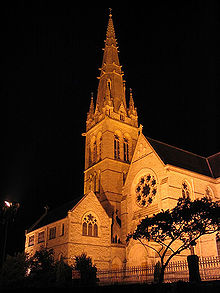 Cathedral of Saints Eunan and Columba of the Roman Catholic Diocese of Raphoe dominates the Letterkenny skyline
Cathedral of Saints Eunan and Columba of the Roman Catholic Diocese of Raphoe dominates the Letterkenny skyline
Many of Letterkenny's more notable buildings were built in the early 1850s—or earlier. These include educational and ecclesiastical buildings. The town's tallest building is the Cathedral of St. Eunan and St Columba, which was completed in 1901. The Cathedral was designed by William Hague from County Cavan. It is built in a light Victorian neo-Gothic version of the French 13th-century Gothic style. Located opposite the Cathedral, at the junction of Church Street with Cathedral Square, is Conwal Parish Church, parts of which date from the 17th century.
Another dominant building in the town is the historic St Eunan's College. St Eunan's is a three-storey castelated structure with four round towers at each corner of the building. It was constructed in the Edwardian version of the neo-Hiberno-Romanesque style. Other architecturally notable buildings can be found at Mount Southwell Terrace, which is located at the top of the Market Square, just off Castle Street. This Georgian-style terrace of red brick was built in 1837 by Lord Southwell. The terrace contains five of the most distinctive examples of Georgian houses in Letterkenny and also served as the holiday home of Maud Gonne who stayed here while on holiday in Donegal.[17] St. Conal's Psychiatric Hospital is a large Victorian neo-Georgian structure located on the Kilmacrennan Road in the town. One of the most notable buildings in West Ulster, the oldest parts date from the 1860s. The hospital's chapel was built in the neo-Norman style in the 1930s.
The Donegal County Museum is housed in the old workhouse and is located on the High Road. It was built in 1843 in the neo-Tudor style typical of this kind of building.
In more recent years, Letterkenny has seen more unusual architectural development. The new Letterkenny Town Council Offices, known locally as "The Grasshouse", were designed by Donegal-based MacGabhann Architects. One of its most notable features is its distinctive sloping grass roof situated above a broad band of aluka matt cladding although it is also noticeable for its runway-like ramp to the first-floor concourse. It is said to be a building of international interest.[18]
See also: Public art in LetterkennyMedia and the arts
Theatre
There is a large cinema complex in the town. Located on Canal Lane, Century Cinemas[19] is an eight-screen cinema. An Grianán Theatre,[20] the largest theatre in County Donegal with a seating capacity of 383. There is the Letterkenny Arts Centre and recent additions to the arts infrastructure include modern additions to Letterkenny Library and Arts Centre and the Cristeph Gallery. Letterkenny Regional Cultural Centre, located behind An Grianán Theatre, opened on 9 July 2007. The town has an active music scene.[citation needed]
Festivals
The town recently hosted the annual Irish traditional music festival, the Fleadh Cheoil for two consecutive years. Both festivals were organised by Comhaltas Ceoltóirí Éireann. The town has also hosted the international Pan Celtic Festival for two consecutive years (2006 and 2007). Celts from Ireland, Wales, Scotland, Isle of Man, Brittany and Cornwall visited Letterkenny for the "craic agus ceoil". Along with the daily street performances on Market Square, An Grianán Theatre and The Courtyard Shopping Centre, song, fiddle, harp and dance contests also featured.
In 2008 Letterkenny represented Ireland in the Entente Florale, having scooped Gold in the Large Urban Centre category of the 2007 National Tidy Town Awards. Locally there was a minor furore as all flags of competing nations were displayed in prominent areas of the town, with some difficulty encountered when locals discovered the controversial Union Jack flag hanging from a pole adjacent to the library and Paddy Delap's newsagent. The flag is still upsetting to many people angered by continuing British rule in Northern Ireland and as such led to an intensely heated debate on local radio station Highland Radio[21][22] on the day the judges were in town. The flag was first mounted the previous day (7 August) and had to be taken down when some concerns were raised about its safety on a busy Thursday night. It was remounted the following day. Nevertheless the town won gold in the competition.[23]
Social
The town is a popular nightlife location for the local catchment area and, indeed, for the rest of Ulster - especially at the weekends and particularly for visitors from nearby Derry City. The Main Street, originally the retail centre of the town, has become a centre for popular night clubs and pubs, boosted by the remnants of its old shopping district. There are several nightclubs in the area including Milan Nightclub which often hosts international tours and DJs and The Pulse who offer live bands regularly.The Grill Music Venue is a popular nightclub on Sundays, which regularly plays host to acts such as Shane McGowan, Ash, Hot Chip, Dirty Sanchez, Fun Lovin' Criminals.[24] Club Voodoo is a highly regarded[25] bar and night-club on Lower Main Street and has attracted figures such as Sander Van Doorn, Markus Schulz, Paul Van Dyk, Eddie Halliwell and Marco V in recent years. There are many pubs such as The Central Bar (established 1808), The Cavern, Sister Sara's, Josie's Bar and The Cottage Bar.
Events
Annual events include the:
- St. Patrick's Day Parade (March)
- North West 10K (May)
- Donegal International Rally (June)
- Earagail Arts Festival (June/July)
- Donegal Harvest Rally (October)
Media
Letterkenny can receive all national radio stations, television stations and cable and satellite services. The area can also receive many Northern Irish stations, including C9TV, a local television station based in Derry. The national broadcaster RTÉ has a studio located in the Ballyraine district.
The local radio station is Highland Radio which broadcasts from the town to north, east and west County Donegal, West Tyrone and the City of Derry. It began broadcasting in 1990.
Letterkenny is home to several media companies. The main regional newspaper in the town and county is The Donegal Democrat (owned by The Derry Journal), whose offices also prints two other titles every week - the Donegal People's Press on Tuesday and also Donegal on Sunday. Another local paper is The Derry People Donegal News (popularly known locally as The Derry People). It is distributed on a Friday, as well as having a Monday edition. The Milford-based Tirconaill Tribune, printed in Letterkenny, is distributed throughout the county. The town also produces two freesheet newspapers, the Letterkenny People (previously the Letterkenny Listener), which is distributed on a Thursday, and the Letterkenny Post, which prints on a Thursday night for Friday circulation. The Derry Journal itself is also a major newspaper in the town and it's environs.
Crime
Letterkenny is one of the worst towns in Ireland for public order offences. There were a total of 777 public order offences recorded in the town in 2003 with 1505 recorded in 2008. These statistics place Letterkenny as the sixth worst town in Ireland for public order offences, worse than the notoriously dangerous Dublin suburbs of Coolock and Clondalkin.[26] This should be placed in the context of the size of Letterkenny, and against a backdrop of a busy nightlife in town, especially on weekends. For the resident population, crime is not a significant factor in their daily lives.
Recent years have seen serious crimes in Letterkenny being linked with feuds between gangs within certain areas of the town, mainly the Mountain Top and Oldtown and the surrounding areas. In one such incident a man was seriously injured when attacked with pitchforks and slash hooks in the Mountain Top area of the town.[27] The Oldtown area has seen several feuds in recent years - dubbed the "Battle of the Oldtown" by the media. In one incident a man was stabbed and another taken to hospital. The gangs used ninja-type weapons of chains and swords. They only calmed upon the intervention of a local priest.[28] Daggers, knives, chains and rapier-type swords were later confiscated by gardaí.[29]
The Main Street has seen numerous assaults,[30] stabbings,[31][32][33][34] sexual assaults,[35][36] drug raids[37] and attacks on Gardaí[38] in the past. Drug crime has become a problem in recent years, notably in the now demolished mart building.[39]
In recent years local community organizations, ranging from the local authority to local businesses, have all set about addressing social issues.
Economy
Retail
The retail trade in Letterkenny includes modern shopping centres and family owned local shops - often providing hand-made crafts.
Many High Street stores operate in Letterkenny. The town is the north-west regions major shopping centre[40] and helps to serve outlying areas including rural County Donegal and Derry. The three main shopping malls are the Courtyard Shopping Centre, the Forte Shopping Centre and the Letterkenny Shopping Centre, the latter being the oldest. These centres feature numerous international and Irish chains such as Marks & Spencer, Tesco, Eason and others. There are also many other small centres such as the Glencar Shopping Centre and the Market Centre.
Previously, Main Street served as the main shopping area in the town but trade has now shifted further afield expanding the town in the process. The Main Street is home to many older establishments including R. McCullagh Jewellers,[41] dating from 1869, and Speers Department Store. Newer shopping areas in the town include the Letterkenny Retail Parks on Pearse Street and Canal Lane. Smaller streets such as Church Street and Castle Street have grown in recent years with businesses such as bakeries, pharmacies and fashion outlets having opened. The Market Square has also attracted fresh business.
Industry
The town's major employers include the General Hospital (which grew from St. Conal's Psychiatric Hospital), Pramerica, and the Department of Social and Family Affairs, the latter having decentralised to the town in 1990, following a government decision to relocate 200 civil service jobs from Dublin.
Letterkenny is at the centre of industry in the northwest of Ireland. Eircom, Boston Scientific and Pacificare are significant employers in the region. As the main commercial centre of north Donegal, Letterkenny also has a host of financial service institutions, legal firms and small businesses. There has been a significant decline in the manufacturing base, while employment has grown in the service sector. Since 2002 there has been a significant expansion in the retail sector. Allied to this growth has been the development of the cultural infrastructure. This includes the opening of An Grianán Theatre and the development of a new arts centre.
Letterkenny is also home of the confectionery manufacturers Oatfield. It is based at the entrance to Ballyraine, near the town's central area. Rockhill Barracks was once a major contributor to the local economy but closed in January 2009 due to military cuts.[42] Modern Timber Homes, a timber-frame manufacturing company is located at Bonagee.
Construction work on a private hospital, which is to provide radiotherapy services to the northwest region, commenced in June 2008. Construction of the first independent hospital in the county will cost €70 million. The hospital will provide four surgical theatres, renal dialysis and an MRI and PET scan. The 1,100m² (12,000 ft²) Wyndale Clinic was due to be completed in 2009.[43]
The economy in the town is strongly dependent on cross-border trade, and times of economic boom are determined mostly by the currency exchange rate between the Euro and the British Pound.
Education
The Letterkenny Institute of Technology[44] (LYIT; known locally as the Regional), which is situated east of the town centre on the Port Road, is a centre for engineering, information technology, materials science, design, business and nursing humanities. The institute has a student population of 3000 and is one of the largest institutes of third level education anywhere in Ulster.
St Eunan's College is a major secondary education centre in Letterkenny. Situated just north-west of the town centre, it was built in 1906.
Primary and secondary education in the town is organised similarly to the rest of Ireland. There are 5 primary schools in Letterkenny, including Scoil Colmcille and Woodland School, while there are 4 secondary schools.[45]
Coláiste Ailigh is one of the "gaelscoileanna" in Letterkenny. It is a secondary school specifically designed for education through the Irish language. It was opened in 2000.
The Loreto Convent Secondary School, adjacent to St Eunan's Cathedral, is over 150 years old.
Sport
See also: List of Letterkenny people - SportsLetterkenny has a modern community purpose-built leisure and sports complex, comprising a swimming pool, football pitches (both natural grass and astroturf), and sports halls. Gaelic football, rugby and soccer are the most popular sports in the town, but many other minority sports are practiced also, such as hurling, boxing, karate, kick-boxing, handball, bowling, golf, swimming and gymnastics.
Gaelic games
There are two Gaelic Athletic Association Clubs in Letterkenny, St Eunan's GAA and Letterkenny Gaels Link label who play their home games at O'Donnell Park and at Páirc na nGael, The Glebe respectively. Almost uniquely in Ireland, Letterkenny Rugby Club and Letterkenny Gaels GAA Club share facilities. Gaelic football, like most of County Donegal, is the predominant sport, although soccer is also very popular.
Rugby
Rugby is also popular in the town, being played at various levels, from school to senior league level. Letterkenny RFC, which was founded in 1973, is the major rugby club in the town. It has recently forged links with New Zealand rugby fraternities due to the fact the first All-Black captain, Dave Gallaher was born in Ramelton, a village eight miles (13 km) from Letterkenny. The club's rugby ground in Letterkenny was named The Dave Gallaher Memorial Park in his honour in November 2005 by a visiting contingent of All-Black players, led by captain Tana Umaga.
Association football
Letterkenny Rovers F.C. are one of the most well-known soccer clubs in the town. The team play their home games at Leckview Park, at Canal Road, in the town. Bonagee United F.C. are another local team and play their home games at Dry Arch Park and Glencar Celtic F.C are another team from the town who play in the Donegal League and recent winners of the Saturday League Cup . There are a number of schoolboy soccer clubs within the town's environs and an annual league is played at Under 12, Under 14 and Under 16 age groups.
Other sports
Letterkenny has two men's basketball teams, Letterkenny Heat and Letterkenny IT, as well as a junior basketball club, Letterkenny Blaze.[46] Letterkenny Golf Club is located just outside the town centre. There are also pitch and putt and tennis facilities in the town. Letterkenny Sports Complex, a state of the art leisure centre complete with skate park, is located on the edge of the town. Letterkenny Athletic Club is also located in the town. The town also hosts the Donegal International Rally on the third weekend of June every year and the Donegal Harvest Rally every October. There is a campaign being run by a local councillor for the construction of a horse racing track and facilities on land at the Big Isle, on the outskirts of the town.[47]
Transport
Letterkenny Infrastructure Hub & Midlands Gateway access
Air
The nearest airport is City of Derry Airport, which is located about 48 kilometres (30 mi) to the east at Eglinton. There are daily flights to London (Stansted), London (Luton), Dublin, Birmingham, Glasgow, and Liverpool, and twice weekly flights to Alicante in Spain.
Donegal Airport (locally known as Carrickfinn Airport) is also less than an hour away, located to the west in The Rosses. Aer Arann provide two flights daily from Carrickfinn Airport to Dublin and flights daily to Glasgow (Prestwick).
The nearest major international airport to Letterkenny is Belfast International Airport (popularly known as Aldergrove Airport), located around seventy-five miles to the south-east at Aldergrove, near Antrim, in County Antrim.
Letterkenny has a small privately operated airfield situated on the outskirts of the town. It is run and operated by the Letterkenny Flying Club. The airstrip is 550 metres of grass and has also a very narrow tarmac strip running alongside it for use by ultralights. The airfield is home to quite a few ultralights and the Flying Club run a big open weekend each June where many planes fly in to attend it. The airfield is only suitable for small private aircraft and ultralights and there is no commercial traffic whatsoever there, it is occasionally used by businessmen to land their small aircraft at and it is approximately 3 miles from the town. The flying club has a website at http://www.LetterkennyFlyingClub.com
Rail
See also: History of Irish railThe town was, in times past, connected with the once extensive narrow gauge rail network of County Donegal. This provided connections to Derry (and through there to Dublin and Belfast), to Lifford and Strabane, to Gweedore and Burtonport, and to Carndonagh, north of Derry. The rail system was built in the late 19th century, with the last extensions opening in the 20th century. Some of these lines were never profitable, built using British government subsidies, described as an attempt to kill the Home Rule movement "with kindness". Only a couple of decades later, political events resulted in rail companies operating across two jurisdictions where there had previously been one. This had devastating effects on an already fragile economic situation, resulting eventually in the final closure of all parts of the rail system in the area by 1960.
Today, the closest railway station to County Donegal is Waterside Station in the nearby City of Derry. This station is owned and run by Northern Ireland Railways (N.I.R.) and runs - via Coleraine - to Belfast.
Road
Letterkenny is well served by road transport. Bus Éireann operates a number of bus services from its bus depot to Dublin(n.32), Derry(n.64) and Galway(n.64) a number of times each day. Many private coach companies have daily services to and from the town. The Lough Swilly Bus Company (popularly known locally as Lough Swilly or the Swilly Bus) operates a local transport service in cooperation with Bus Éireann. Currently, access from Dublin is improving with motorway status roads being constructed along the route, allowing cars to complete the Dublin-Letterkenny journey in about 3hours 30mins. Galway, to the south, is 4 hours away by car, while Belfast, to the south-east, by car, is only 2 hours away.
A number of private companies provide daily bus services to Belfast several times per day, especially Patrick Gallagher Coaches, who are based at Brinalack in Gaoth Dobhair. Rather surprisingly, Letterkenny has no state bus service (in other words, a service provided from the Bus Station by Bus Éireann and Ulsterbus) linking it directly to Belfast. This means that (as of October 2010) Letterkenny is the only major town in all of Ulster not to have a state bus service linking it directly to Belfast.
Taxi services are available from a rank on the Main St. at the Market Square.
Two national primary roads serve the town: the N13 from the South (Stranorlar) and the N14 from the East (Lifford).
Youth facilities
A number of youth groups provide services and support within Letterkenny.
The Loft LK (Learning Opportunities For Teens) is located on Port Road on a site previously occupied by the old cinema. Opened in April 2006, the LOFT provides a supervised meeting environment, offering music, computer games, satellite TV, a pool table, and other amenities. Band nights, a film club, and other social events are sometimes hosted. The LOFT offers courses in media studies, health, leadership, writing, arts and crafts, sign language, teambuilding, photography and personal development.
The Youth Information Centre (YIC) is located in the same building as the LOFT. It offers computers and broadband facilities, information that may be of interest to young people and also offers a wide range of courses and groups including a very successful media group where young people get the opportunity to work on radio and TV production.
Letterkenny Youth Theatre is run in association with An Grianán Theatre and usually meets on Fridays. It offers young people the opportunity to gain experience in acting and stage management. It has run a number of small one-off productions and ran productions in early 2007 in An Grianán.
Sister towns/cities
The following places are twinned with Letterkenny:
 Elizabethtown, Pennsylvania, United States[48]
Elizabethtown, Pennsylvania, United States[48] Wieluń, Poland[49]
Wieluń, Poland[49] Derry, Northern Ireland
Derry, Northern Ireland
See also
- Public art in Letterkenny
- List of Letterkenny People
- List of venues for All Ireland Fleadh Cheoil na hÉireann (Letterkenny 2005 & 2006)
- List of Donegal people
- List of towns and villages in the Republic of Ireland
- List of towns in Northern Ireland
- Market Houses in the Republic of Ireland
Footnotes
- ^ a b c "Census 2006 – Volume 1 – Population Classified by Area" (PDF). Central Statistics Office Census 2006 Reports. Central Statistics Office Ireland. April 2007. http://www.cso.ie/census/documents/census2006_volume_1_pop_classified_by_area.pdf. Retrieved 2011-05-16.
- ^ Draft Letterkenny Plan 2009 - 2015 Volume 1 - Page 75
- ^ [1]
- ^ Best Kept Town
- ^ Tidiest Large Urban Centre
- ^ Letterkenny as filthy as Liberties Belfast Telegraph May 29, 2002
- ^ Letterkenny is Irelands 15th cleanest town www.ivideo.ie 2010
- ^ Donegal News - 18 April 2007.
- ^ Wolf Tone Captured in Letterkenny
- ^ Only Warehouse Architecture remains
- ^ Letterkenny Population Rise
- ^ From timber homes to god-house; Irish Independent August 21, 2007
- ^ Letterkenny Indian Community Centre
- ^ Donegal Democrat report, 31 July 2007
- ^ Donegal News report, 9 November 2007
- ^ Census 2006 - Irish Travellers
- ^ Mount Southwell, on flickr. com (accessed 2008-05-29)
- ^ "In the ascendant", Archiseek, August 4, 2002 (accessed 2008-05-29)
- ^ Century Cinemas Website (accessed on 2008-05-29)
- ^ An Grianán Theatre Website (accessed on 2008-05-29)
- ^ [2]
- ^ [3]
- ^ Letterkenny wins gold medal in Entente Florale Highland Radio September 22, 2008
- ^ Live at the Grill
- ^ [4]
- ^ Letterkenny listed as one of worst towns for public order offences, Donegal News, March 16, 2009
- ^ Traveller Feud
- ^ Priest to help end dispute, Irish News, October 27, 2007
- ^ Battle of the Oldtown
- ^ Gardai issue appeal to licensed trade after serious assaults in Letterkenny, Belfast Telegraph, May 22, 2007
- ^ Man due in court over Donegal stabbing, Irish Independent, October 17, 2008
- ^ Two hurt in separate assaults, Irish Independent, October 10, 2006
- ^ Dubliner held on stabbing and drug supply charges, Irish Times, October 14, 2008
- ^ Horror Knife Attack, Donegal News, 18 September 2009
- ^ Gardai fear spate of sex attacks are linked, Irish Independent, November 23, 2002
- ^ Gardai launch search for sex-attack duo, Irish Independent, February 6, 2006
- ^ Gardaí make two cannabis seizures overnight, Irish Times, September 9, 2001
- ^ Spitting Letterkenny man "beginning, middle and end of a blaggard" - Judge Kilrane, Donegal Democrat, September 9, 2008
- ^ Letterkenny Post 18 April 2008 - Tear It Down
- ^ Letterkenny Shopping Capital of North-West
- ^ R. McCullagh Jewellers Website (accessed 2008-05-29)
- ^ Four army barracks, military hospital to be closed Irish Independent, October 15, 2008
- ^ Letterkenny Private Hospital
- ^ Letterkenny Institute of Technology Website (accessed 2008-05-29)
- ^ Education, at Letterkenny Guide.com
- ^ http://www.blazebasketball.ie
- ^ Horse Racing Facilities
- ^ Elizabethtown Borough Website (accessed 2008-05-29)
- ^ Wielun Website (in English) (accessed 2008-05-29)
External links
- Letterkenny Online, Letterkenny's Online Information Centre
- Letterkenny Town Council
- Letterkenny Chamber of Commerce and Industry
- Map of Letterkenny
- Letterkenny Community Centre
Places in County Donegal Towns Villages - Annagry
- Ardara
- Ballintra
- Ballyliffin
- Bridgend
- Bruckless
- Burtonport
- Carrigans
- Carrigart
- Castlefin
- Churchill
- Cloghan
- Clonmany
- Creeslough
- Doochary
- Dunfanaghy
- Dunkineely
- Fahan
- Falcarragh
- Fintown
- Frosses
- Glen
- Glencolmcille
- Glenties
- Greencastle
- Gweedore
- Inver
- Kerrykeel
- Kilcar
- Killea
- Killygordon
- Laghey
- Lettermacaward
- Loughanure
- Malin
- Manorcunningham
- Milford
- Mountcharles
- Muff
- Narin
- Newtowncunningham
- Pettigo
- Portnablagh
- Quigley's Point
- Rathmullan
- Rossnowlagh
- St. Johnston
- Teelin
Townlands Islands - Arranmore
- Glashedy
- Gola
- Inishbofin
- Inishtrahull Island
- Rotten Island
- Rutland
- Tory Island
- List of townlands in County Donegal
- Category:Mountains and hills of County Donegal
- Category:Rivers of County Donegal
- Category:Geography of County Donegal
Letterkenny Districts 
Media Radio Print Education Third-level Second-level Sport Soccer Gaelic Rugby Stadia Landmarks Church of the Irish Martyrs · Conwal Parish Church · Donegal County Museum · St. Conal's Psychiatric Hospital · Cathedral of St. Eunan and St ColumbaAmenities Ballymacool Park · Club Voodoo · Golf Club · An Grianán Theatre · Grill Music Venue · Library · Town Park · Regional Cultural Centre · Sports ComplexRetail Industry Other Categories:- Untranslated Irish place names
- Letterkenny
- Populated places established in the 17th century
- Towns and villages in County Donegal
Wikimedia Foundation. 2010.

